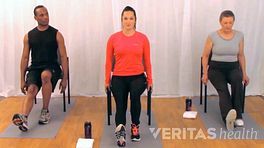An important component of any exercise program is aerobic exercise, which elevates the heart rate and improves circulation. Aerobic exercise can help relieve back pain by decreasing stiffness and improving blood flow to the spinal structures, increasing the amount of nutrients reaching the spine.
Low-impact exercise can elevate the heart rate without jarring the spine and worsening back pain, a preferable option for those with back pain.
Benefits of Aerobic Exercise
A regular routine of aerobic exercise can help alleviate neck or back pain by:
- Reducing the likelihood and/or severity of potential future painful flare-ups
- Keeping the spine functional and mobile, limiting disability caused by chronic pain. Not exercising with chronic back pain will typically worsen mobility and functionality.
- Burning calories to help achieve and maintain optimal weight, which can remove excess pressure on the spine
- Increasing production of endorphins, which act as a natural painkiller and can elevate mood to relieve symptoms of depression
Typical recommendations for aerobic exercise include at least a 20 to 30-minute workout between 3 and 5 times a week to effectively improve circulation.1 For severe pain, it may be helpful to start with shorter intervals of exercise, such as 5 to 10-minutes of walking, and gradually work up to a more extensive routine.
Types of Low-Impact Exercise
Popular low-impact aerobic exercises include:
- Exercise walking. Exercise walking differs from everyday walking in that it is faster paced with the goal of elevating the heart rate and gently working the muscles. Exercise walking has the advantage of being gentler on the spine than jogging, not requiring special equipment (except a good pair of shoes), and being available in almost any location. Wearing ankle or wrist weights can add some resistance to the exercise. Walking can be done inside, such as in a mall or on a treadmill, or outdoors, such as on a nature trail or around the neighborhood.
- Elliptical trainer or step machine. These machines simulate the movements of jogging, running, and walking up stairs to provide a low-impact aerobic workout. Most machines use pedals or footholds suspended above the ground that glide up and down, so the feet never hit a hard surface during the workout. Additionally, many machines include an array of resistance settings that can help strengthen muscles.
- Stationary bicycling. A stationary bicycle mimics the pedaling motion of a bicycle, providing aerobic exercise without the jostling impact of riding on uneven ground. Stationary biking may be preferable as part of a spinning class, which is guided by an instructor and often available in a variety of workout options for beginners or more experienced cyclers. Stationary bikes come in upright models, which involve leaning forward, and recumbent models, which provide back support in an adjustable, reclined position.
See Stationary Bike
- Swimming and water aerobics. Exercise while in the water combines added resistance and natural buoyancy to provide aerobic exercise with minimal impact on the spine. Water aerobics and swimming may be considered if a workout on a hard surface may be too painful. Specific water exercises or swim strokes may be taught as part of a class or recommended by a doctor.
Finding the right aerobic exercise routine is typically dependent on personal preferences and may involve a process of trial and error. Other options may be recommended that better suit a particular condition, pain levels, and lifestyle.
References
- 1. American Heart Association Recommendations for Physical Activity in Adults . American Heart Association. July 27, 2016. Accessed June 2, 2017.






